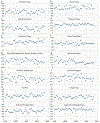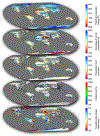Emerging trends in global freshwater availability
- PMID: 29769728
- PMCID: PMC6077847
- DOI: 10.1038/s41586-018-0123-1
Emerging trends in global freshwater availability
Erratum in
-
Author Correction: Emerging trends in global freshwater availability.Nature. 2019 Jan;565(7739):E7. doi: 10.1038/s41586-018-0831-6. Nature. 2019. PMID: 30604767
Abstract
Freshwater availability is changing worldwide. Here we quantify 34 trends in terrestrial water storage observed by the Gravity Recovery and Climate Experiment (GRACE) satellites during 2002-2016 and categorize their drivers as natural interannual variability, unsustainable groundwater consumption, climate change or combinations thereof. Several of these trends had been lacking thorough investigation and attribution, including massive changes in northwestern China and the Okavango Delta. Others are consistent with climate model predictions. This observation-based assessment of how the world's water landscape is responding to human impacts and climate variations provides a blueprint for evaluating and predicting emerging threats to water and food security.
Conflict of interest statement
The authors claim no competing financial interests.
Figures












References
-
- Changnon SA Detecting drought conditions in Illinois. Circular 169 (Illinois State Water Survey, 1987).
-
- Rodell M, & Famiglietti JS An analysis of terrestrial water storage variations in Illinois with implications for the Gravity Recovery and Climate Experiment (GRACE). Wat. Resour. Res 37, 1327–1340, doi:10.1029/2000WR900306 (2001). - DOI
-
- Getirana A, Kumar S, Girotto M, & Rodell M Rivers and floodplains as key components of global terrestrial water storage variability. Geophys. Res. Lett 44, 10359–10368, doi: 10.1002/2017GL074684 (2017). - DOI
-
- Luthcke SB et al. Antarctica, Greenland and Gulf of Alaska land ice evolution from an iterated GRACE global mascon solution. J. Glac 59, 613–631, doi:10.3189/2013JoG12J147 (2013). - DOI
-
- Velicogna I, Sutterley TC, & van den Broeke MR Regional acceleration in ice mass loss from Greenland and Antarctica using GRACE time-variable gravity data. Geophys. Res. Lett 41, 8130–8137, doi:10.1002/2014GL061052 (2014). - DOI
Publication types
MeSH terms
Grants and funding
LinkOut - more resources
Full Text Sources
Other Literature Sources

